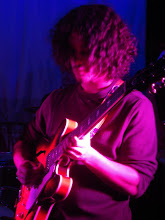For all that talk of drop 2 and 4 voicings, I really don’t know what to do with a lot of them. Unlike drop 2s, there is a much more limited range where they sound good. But starting to look at them in greater detail has reminded me of something I have meant to do for a long time and is certainly connected to the work I’m doing now in terms of creating more angular and jagged melodic textures.
I recently asked myself why I’ve been doing something for seven years and then decided to change it. This first thing I realized was that I always played consecutive triads voice-led melodically in the same direction and always the same inversion as a consequence. Well now I’m asking another question: why are my arpeggios always derived from closed position voicings?
An arpeggio is a chord except the notes are played individually. On a guitar we have very few closed position voicings that are convenient (and you can see many a guitarist sweep through them excessively on a Bbmaj7 or Gm7 chord). As a result, we tend to think of our arpeggios as derived from a scale because they often contain more than one note per string. This is also true but it doesn’t help us understand what’s about to come.
Once we understand that an arpeggio is just a different way to express a chord voicing, we can start to experiment with different chord voicings that involve greater leaps and inversions of chords.
Part of why this is so unintuitive and difficult to integrate into our playing is because these sounds are very difficult to sing, especially if we’re not the best singers. It appears that many people sing while they play because it makes them SEEM more expressive or in control of the sounds coming from their instrument, not because it actually MAKES them more expressive or in control. And there’s an inherent limitation to playing what we sing: we have to be able to sing everything we play. And as guitarists we are capable of doing things melodically which only a truly expert singer could ever even stand a chance of reproducing vocally, especially in tempo.
We put so much time into playing extensions, triads, and all sorts of stuff over our chords, but we always voice them in the way that is most singable to our terrible guitarist voices. Why not try and use a drop 2 voicing or drop 2&4 voicing as the basis for a melodic idea? Because we’re not good enough singers to sing three consecutive and large ascending intervals (i.e. 5th, 6th, 5th in the case of drop 2&4). But this is an interesting and modern sound! We should learn it and learn to hear it and understand it’s nuance but not ask ourselves to be able to sing it in any kind of performable way.
When we learn the lick we should play it slowly and sing each note, practice each interval, and be able to sing the lick at a very slow tempo or out of tempo. This is enough to be able to hear and appreciate the intervallic nuance of a line. So break out the inversions!


No comments:
Post a Comment